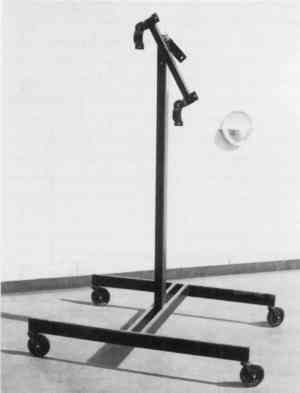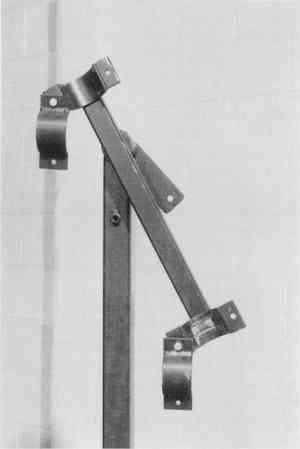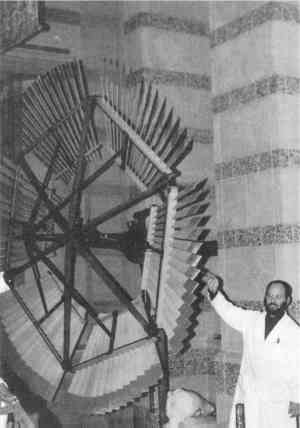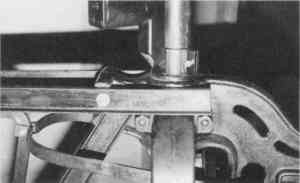SMOOTH MOVES: SUGGESTIONS FOR OBJECT TRANSPORT AND STORAGE EQUIPMENTPAUL S. STORCH
ABSTRACT—Preventive conservation includes the proper handling and transport of objects within the collecting institution. Two devices were developed at the Minnesota Historical Society for moving both small three-dimensional objects and large functional objects. The design of these devices was a collaborative project of the conservation, exhibits, and museum collection departments. Plans for the modification of an ordinary molded plastic service cart are included, enabling readers to create their own padded carts for safer transport. TITRE—D�m�nagement en douceur: Suggestions pour le transport d'objets et l'�quipement du magasin. R�SUM�—La conservation pr�ventive comprend le transport et le maniement correct de objets au sein des institutions qui les collectionnent. � la Soci�t� Historique du Minnesota, deux syst�mes ont �t� sp�cialement con�us pout le transport d'objets tri-dimensionels de petite dimension et celui de grands objets fonctionnels. Le dessin de ces syst�mes a �t� �labor� en collaboration avec les services de restauration, des expositions et des collections. Les plans pour la modification de chariots en plastique moul� ordinaires sont inclus dans l'article et permettront aux lecteurs de cr�er leur propre chariot rembourr� pour un transport plus su∘r. TITULO—Movimientos suaves: Sugerencias para transporte de piezas y equipamiento de dep�sitos. RESUMEN—La conservaci�n preventiva incluye el manejo y transporte correctos de piezas dentro de la instituci�n que colecciona. En la Sociedad Hist�rica de Minesota de desarrollaron dos artefactos que sirven para transportar objetos tridimensionales peque�os y objetos funcionales largos. El dise�o de estos artefactos fue un proyecto conjunto de los departamentos de conservaci�n, de exhibici�n y de colecciones del museo. Se incluyen planos para modificar un carro de servicio com�n de pl�stico moldeado. Esto permitir� a los lectores crear su propio carro acolchado para realizar transportes m�s seguros. 1 INTRODUCTIONMuch unnecessary damage to museum collections objects can be avoided with proper handling. Often, proper handling requires proper equipment. It is becoming widely recognized in the conservation profession that low-level vibrations, such as those transmitted through the vibration of hard cart wheels on a concrete floor, can cause damage to susceptible objects (CCI 1990; Marcon 1996). Supports for large functional objects may have to be designed and constructed as an early part of the treatment scheme in order to have the object in the proper position to treat it. When large and heavy objects are properly supported and positioned, conditions are safe for both the conservator and the object. After treatment, the object can be kept on the support for movement and storage. A full discussion of vibration and vibration mitigation methods is beyond the scope of this article. What will be discussed are two practical suggestions for devices that have been built and used at the Minnesota Historical Society for safely moving and holding objects. 2 MODIFIED SERVICE CARTThe plans for vibration-mitigation alterations to a commercial molded-rubber service cart (fig. 1) were developed by Frank Paraday, a fabricator in the Exhibits Mount Shop. These carts are frequently
3 WINDMILL HEAD SUPPORTThis section describes a mobile support stand that was designed and built for a specific object. However, the principles can be applied to similar large, heavy machinery. A Waupon Self-Regulating Windmill head was conserved and reassembled in the John and Martha Daniels Objects Conservation Laboratory. To facilitate the attachment of the
4 SUMMARYIt is hoped that the preceding examples will be helpful guides for designing and constructing storage support and transport equipment. A minimal investment in time and materials can go a long way in preventing unnecessary damage to collections. All of the departments at the Minnesota Historical Society that are responsible for moving objects in the building now have these modified carts or are in the process of retrofitting older carts. Part of the acquisitions process for large functional objects at the historical society is planning and SOURCES OF MATERIALSDuramold plastic commercial service cart, 24 � 36 in. Catalog No. # 5Z089Grainger, 115 State St., St. Paul, Minn. 55107, (612) 292-0311 Hammin Multi-Purpose casters, cushioned rubber wheels. Catalog 100, catalog no. 2502T78 (rigid); 2877T31 (2502T74).McMaster-Carr Supply Co., P.O. Box 4355, Chicago, Ill. 60680-4355, (630) 833-0300 APA plywoodAvailable from local lumberyards Latvian birch is one type that is glued with phenol-formaldehyde resin. Check with the supplier for a definite identification before purchase.Thermogrip EVA hot-glue sticks. Catalog no. 31923201, Black and Decker, Inc.Available from local hardware suppliers Polyethylene foam blocksAvailable from local plastics and foam suppliers Volara EVA foam sheeting with acrylic adhesive backing, 54 in. wide, 3/16 in. thick. Catalog 100, catalog no. 8722K63McMaster-Carr Supply Co., P. O. Box 4355, Chicago, Ill. 60680-4355, (630) 833-0300 ACKNOWLEDGEMENTSThe author would like to thank Frank Paraday and Jay Erikson, MHS Exhibits Department, for the cart and windmill mount designs, respectively; as well as Miranda Martin and Jessica Johnson for their kind encouragement to publish this article in the JAIC. REFERENCESMarcon, P. J.1996. Mitigating the effects of shock and vibration. Paper presented at the presession, American Institute for Conservation, 24th Annual Meeting, Norfolk, Virginia. Washington, D.C.: American Institute for Conservation. Marcon, P. J., and T. J. K.Strang. 1990. Cushion design using the CCI Cushion Design Calculator and PadCAD. CCI Notes. Ottawa: Canadian Conservation Institute. Draft, 1–2. AUTHOR INFORMATIONPAUL S. STORCH received a B.A. in anthropology and archaeology from Case Western Reserve University in 1978 and an M.A. in anthropology and museum studies with a concentration in archaeological and ethnographic conservation from the George Washington University in 1982. He has worked as an associate conservator of objects at the Materials Conservation Laboratory, Texas Memorial Museum, Austin, and as chief conservator of the South Carolina State Museum, Columbia, where he helped to develop the first conservation program. He is currently the objects conservator and objects lab section head at the Minnesota History Center (MHC), Minnesota Historical Society, St. Paul. Besides treatment of the museum and historic sites collections, he is engaged with testing manufactured materials prior to use and with the ongoing electronic environmental data logging of the MHC and several historic sites around the state. He is a Professional Associate of AIC, a past Objects Specialty Group chair, and the editor/publisher of Leather Conservation News. Address: John and Martha Daniels Objects Conservation Laboratory, Minnesota Historical Society, 345 Kellogg Blvd. W., St. Paul, Minn. 55102–1906.
 Section Index Section Index |




